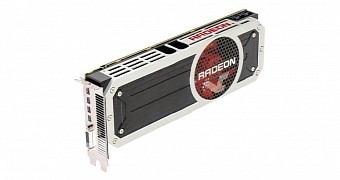Last week, Advanced Micro Devices confirmed that at least two Radeon R9 300 graphics cards were on the way to stores. Now we know a bit more on the subject, but the information is not as exciting as one might have hoped.
In truth, we did not truly expect AMD to actually launch a new GPU generation all that early in the year, but there is always room for hope.
Especially with both mobile and business PC CPUs having already advanced by a generation in the case of the Broadwell line.
Nevertheless, AMD is not moving everything from 28nm to 20nm here. Instead, it has prepared the 28nm GPU refresh series.
The Grenada GPU
While Hawaii powers the Radeon R9 290X and 280X graphics cards, Grenada will take over in the Radeon R9 380X and 380.
It is essentially a Hawaii chip with a speed bump, but probably nothing else going for it. Business as usual in other words.
The Hawaii has 2,816 GCN (graphics core-next) stream processors, 176 texture mapping units (TMUs), 64 raster operating units (ROPs), and a GDDR5 memory interface of 512 bits.
The Grenada will be identical, physically, but naturally faster, possibly by 5-10% compared to the Hawaii.
The goal is to make the Radeon R9 380 and 380X capable of performing better than the GeForce GTX 970 and (maybe) GTX 980 from NVIDIA.
Energy efficiency will be unchanged, so the TDPs of the cards will be the same as for their predecessors. Well, probably. The Radeon R9 280X is a 250W card, and the extra clock should manage to leave it alone.
The Tonga GPU
The graphics processing units found in the Radeon R9 285 will be used in the Radeon R9 370 and 370X cards. No physical changes expected here either: 2,048 GCM cores, 32 ROPs, 128 TMUs, 384-bit GDDR5 interface.
The Fiji GPU
This is the only new processor in the collection and will be used in Radeon R9 390X and 390 cards, with 4,096 stream processors, 256 TMUs, 128 ROPs, and a 1024-bit wide HBM memory interface (4 GB HBM memory likely to be installed on the card).
NVIDIA will only adopt High-Bandwidth-Memory in Pascal, which is months or even years away.
In addition to the single-GPU Radeon R9 390 and 390X graphics cards, AMD will introduce a Radeon R9 390X2 dual-GPU board at some point. Probably in the fourth quarter of the year instead of Q2 2015.

 14 DAY TRIAL //
14 DAY TRIAL //